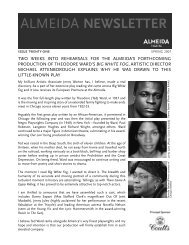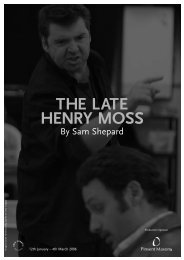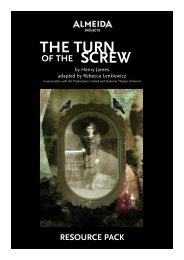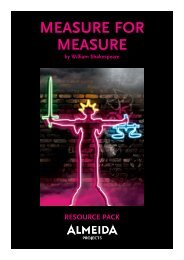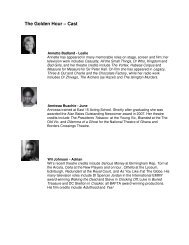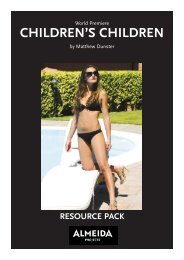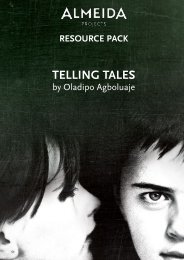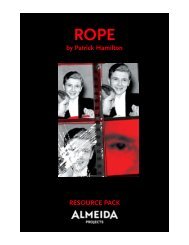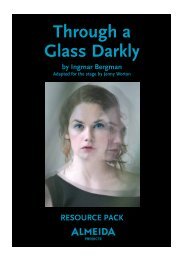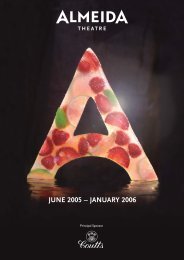The Last Days of Judas Iscariot - Almeida Theatre
The Last Days of Judas Iscariot - Almeida Theatre
The Last Days of Judas Iscariot - Almeida Theatre
Create successful ePaper yourself
Turn your PDF publications into a flip-book with our unique Google optimized e-Paper software.
Donna Croll in rehearsal<br />
Photo: Hugo Glendinning<br />
Storytelling<br />
<strong>The</strong> <strong>Last</strong> <strong>Days</strong> <strong>of</strong> <strong>Judas</strong> <strong>Iscariot</strong> employs a number <strong>of</strong> storytelling<br />
conventions to help tell the story, such as:<br />
• Freeze frames<br />
• Direct address (characters have direct dialogue with the<br />
audience through monologues, and the lawyers appeal<br />
to us as jury members)<br />
• Flashbacks<br />
• Multimedia<br />
<strong>The</strong>se storytelling conventions are <strong>of</strong>ten used and then discarded.<br />
<strong>The</strong>re is nothing consistent about the storytelling and it<br />
changes from moment to moment. This is challenging for any<br />
actor as he/she has to accept what happens in any given<br />
moment, go with it completely, embrace it, and tell the story in<br />
the fullest sense! <strong>The</strong> principle <strong>of</strong> staying in the moment is<br />
fundamental to the play, so a good practical exercise would be<br />
Meisner’s Repetition. Two actors face each other and repeat their<br />
observations about one another back and forth. An example <strong>of</strong><br />
such an exchange might be:<br />
A: You're smiling.<br />
B: I'm smiling.<br />
A: You're smiling!<br />
B: Yes, I'm smiling.<br />
<strong>The</strong> actors are asked to observe and respond to each other’s<br />
behaviour. If they can respond spontaneously to how their partner's<br />
behaviour affects them, their own behaviour will arise<br />
directly from the stimulus <strong>of</strong> the other.<br />
Think on Your Feet<br />
This notion <strong>of</strong> thinking on your feet can be extended through the<br />
Point and Talk exercise. <strong>The</strong> actor should point at something in<br />
the room, but say something else (not the thing they are pointing<br />
at). So if they point at a table, they might say ‘cat.’ <strong>The</strong> idea<br />
is that the actor doesn’t think, he/she just responds, and keeps<br />
pointing and talking for a fixed time (say 5 minutes). If the actor<br />
cannot think <strong>of</strong> anything to say, he/she should continually point<br />
at the same object and repeat ‘nothing’ until something comes<br />
into their head, thus responding until the impulse to change<br />
occurs.<br />
Practical Exercises<br />
Conveying Relationships<br />
<strong>The</strong> relationship between Jesus and <strong>Judas</strong> lies at the core <strong>of</strong> the<br />
play, but actually there are few opportunities where an audience<br />
sees them interacting. Consequently, the actors have been finding<br />
ways to tell the story <strong>of</strong> their relationship to support what<br />
happens throughout the play. <strong>The</strong>re are interludes between<br />
scenes to show the audience something about the dynamic <strong>of</strong><br />
Jesus and <strong>Judas</strong>’ friendship. For example at one point we see<br />
them playing basketball together, and at another point we see<br />
them sharing a cigarette. Can you devise a series <strong>of</strong> interludes,<br />
with no words, that illustrates the complex nature <strong>of</strong> the relationship<br />
between Jesus and <strong>Judas</strong><br />
<strong>Almeida</strong> Projects: <strong>The</strong> <strong>Last</strong> <strong>Days</strong> <strong>of</strong> <strong>Judas</strong> <strong>Iscariot</strong> by Stephen Adly Guirgis<br />
19



